Integer Search Algorithm: A New Discrete Multi-Objective Algorithm for Pavement Maintenance Management Optimization
Abstract
:1. Introduction
2. Pavement Maintenance Model
2.1. Pavement Condition Evaluation
2.2. Pavement Preservation Treatments
2.3. Performance Jumps
3. Optimization Methodology
3.1. Integer Search Algorithm
3.2. Objective Function
3.3. Genetic Algorithm
3.4. Optimization Procedure
4. Case Study
5. Results and Discussion
6. Conclusions
Author Contributions
Funding
Institutional Review Board Statement
Informed Consent Statement
Data Availability Statement
Acknowledgments
Conflicts of Interest
References
- France-Mensah, J.; O’Brien, W.J. Developing a Sustainable Pavement Management Plan: Tradeoffs in Road Condition, User Costs, and Greenhouse Gas Emissions. J. Manag. Eng. 2019, 35, 04019005. [Google Scholar] [CrossRef]
- Fwa, T.F.; Chan, W.T.; Hoque, K.Z. Multiobjective optimization for pavement maintenance programming. J. Transp. Eng. 2000, 126, 367–374. [Google Scholar] [CrossRef]
- Wei, J.; Kong, Y.; Fu, Z. Multi-objective optimization for pavement maintenance and rehabilitation strategies. In Proceedings of the International Conference on Transportation Engineering 2009, Chengdu, China, 25–27 July 2009; pp. 2919–2924. [Google Scholar]
- Torres-Machi, C.; Pellicer, E.; Yepes, V.; Chamorro, A. Towards a sustainable optimization of pavement maintenance programs under budgetary restrictions. J. Clean. Prod. 2017, 148, 90–102. [Google Scholar] [CrossRef] [Green Version]
- Konak, A.; Coit, D.W.; Smith, A.E. Multi-objective optimization using genetic algorithms: A tutorial. Reliab. Eng. Syst. Saf. 2006, 91, 992–1007. [Google Scholar] [CrossRef]
- Abaza, K.A. Iterative linear approach for nonlinear nonhomogenous stochastic pavement management models. J. Transp. Eng. 2006, 132, 244–256. [Google Scholar] [CrossRef]
- Butt, A.A.; Shahin, M.Y.; Carpenter, S.H.; Carnahan, J.V. Application of Markov process to pavement management systems at network level. In Proceedings of the 3rd International Conference on Managing Pavements, San Antonio, TX, USA, 22–26 May 1994; Volume 2, pp. 159–172. [Google Scholar]
- Wu, Z.; Flintsch, G.W.; Chowdhury, T. Hybrid multiobjective optimization model for regional pavement-preservation resource allocation. Transp. Res. Rec. 2008, 2084, 28–37. [Google Scholar] [CrossRef]
- Durango-Cohen, P.L.; Sarutipand, P. Maintenance optimization for transportation systems with demand responsiveness. Transp. Res. Part C Emerg. Technol. 2009, 17, 337–348. [Google Scholar] [CrossRef]
- Gu, W.; Ouyang, Y.; Madanat, S. Joint optimization of pavement maintenance and resurfacing planning. Transp. Res. Part B Methodol. 2012, 46, 511–519. [Google Scholar] [CrossRef]
- Dissanayake, S.; John Lu, J.; Chu, X.; Turner, P. Use of multicriteria decision making to identify the critical highway safety needs of special population groups. Transp. Res. Rec. 1999, 1693, 13–17. [Google Scholar] [CrossRef]
- Farhan, J.; Fwa, T.F. Incorporating priority preferences into pavement maintenance programming. J. Transp. Eng. 2012, 138, 714–722. [Google Scholar] [CrossRef]
- Lambert, J.H.; Wu, Y.-J.; You, H.; Clarens, A.; Smith, B. Climate change influence on priority setting for transportation infrastructure assets. J. Infrastruct. Syst. 2013, 19, 36–46. [Google Scholar] [CrossRef] [Green Version]
- Gharaibeh, N.G.; Chiu, Y.-C.; Gurian, P.L. Decision methodology for allocating funds across transportation infrastructure assets. J. Infrastruct. Syst. 2006, 12, 1–9. [Google Scholar] [CrossRef]
- Giustozzi, F.; Crispino, M.; Flintsch, G. Multi-attribute life cycle assessment of preventive maintenance treatments on road pavements for achieving environmental sustainability. Int. J. Life Cycle Assess. 2012, 17, 409–419. [Google Scholar] [CrossRef]
- Li, Z.; Sinha, K.C. Methodology for multicriteria decision making in highway asset management. Transp. Res. Rec. 2004, 1885, 79–87. [Google Scholar] [CrossRef]
- Farhan, J.; Fwa, T.F. Pavement maintenance prioritization using analytic hierarchy process. Transp. Res. Rec. 2009, 2093, 12–24. [Google Scholar] [CrossRef]
- Šelih, J.; Kne, A.; Srdić, A.; Žura, M. Multiple-criteria decision support system in highway infrastructure management. Transport 2008, 23, 299–305. [Google Scholar] [CrossRef] [Green Version]
- Shelton, J.; Medina, M. Integrated multiple-criteria decision-making method to prioritize transportation projects. Transp. Res. Rec. 2010, 2174, 51–57. [Google Scholar] [CrossRef]
- Sun, L.; Gu, W. Pavement condition assessment using fuzzy logic theory and analytic hierarchy process. J. Transp. Eng. 2011, 137, 648–655. [Google Scholar] [CrossRef]
- Chan, W.T.; Fwa, T.F.; Tan, J.Y. Optimal fund-allocation analysis for multidistrict highway agencies. J. Infrastruct. Syst. 2003, 9, 167–175. [Google Scholar] [CrossRef]
- Chootinan, P.; Chen, A.; Horrocks, M.R.; Bolling, D. A multi-year pavement maintenance program using a stochastic simulation-based genetic algorithm approach. Transp. Res. Part A Policy Pract. 2006, 40, 725–743. [Google Scholar] [CrossRef]
- Mathew, B.S.; Isaac, K.P. Optimisation of maintenance strategy for rural road network using genetic algorithm. Int. J. Pavement Eng. 2014, 15, 352–360. [Google Scholar] [CrossRef]
- Morcous, G.; Lounis, Z. Maintenance optimization of infrastructure networks using genetic algorithms. Autom. Constr. 2005, 14, 129–142. [Google Scholar] [CrossRef]
- Pilson, C.; Hudson, W.R.; Anderson, V. Multiobjective optimization in pavement management by using genetic algorithms and efficient surfaces. Transp. Res. Rec. 1999, 1655, 42–48. [Google Scholar] [CrossRef]
- Santos, J.; Ferreira, A.; Flintsch, G. An adaptive hybrid genetic algorithm for pavement management. Int. J. Pavement Eng. 2019, 20, 266–286. [Google Scholar] [CrossRef]
- Shen, Y.; Bu, Y.; Yuan, M. A novel chaos particle swarm optimization (PSO) and its application in pavement maintance decision. In Proceedings of the 2009 4th IEEE Conference on Industrial Electronics and Applications, Xi’an, China, 25–27 May 2009; pp. 3521–3526. [Google Scholar]
- Tayebi, N.R.; Moghadasnejhad, F.; Hassani, A. Analysis of pavement management activities programming by particle swarm optimization. In Proceedings of the International Conference on Advances in Electrical & Electronics, Trivandrum, Kerala, India, 1 January 2010; pp. 149–154. [Google Scholar]
- Mahmood, M.; Mathavan, S.; Rahman, M. A parameter-free discrete particle swarm algorithm and its application to multi-objective pavement maintenance schemes. Swarm Evol. Comput. 2018, 43, 69–87. [Google Scholar] [CrossRef] [Green Version]
- Greco, S.; Matarazzo, B.; Słowiński, R. Dominance-based rough set approach to interactive multiobjective optimization. In Multiobjective Optimization; Springer: London, UK, 2008; pp. 121–155. [Google Scholar]
- Augeri, M.G.; Colombrita, R.; Greco, S.; Lo Certo, A.; Matarazzo, B.; Slowinski, R. Dominance-based rough set approach to budget allocation in highway maintenance activities. J. Infrastruct. Syst. 2011, 17, 75–85. [Google Scholar] [CrossRef]
- Augeri, M.G.; Greco, S.; Nicolosi, V. Planning urban pavement maintenance by a new interactive multiobjective optimization approach. Eur. Transp. Res. Rev. 2019, 11, 17. [Google Scholar] [CrossRef] [Green Version]
- Zhao, M.; Chen, Z.; Blaabjerg, F. Optimisation of electrical system for offshore wind farms via genetic algorithm. IET Renew. Power Gener. 2009, 3, 205–216. [Google Scholar] [CrossRef]
- Shin, H.-U.; Lee, K.-B. Optimal design of a 1 kW switched reluctance generator for wind power systems using a genetic algorithm. IET Electr. Power Appl. 2016, 10, 807–817. [Google Scholar] [CrossRef]
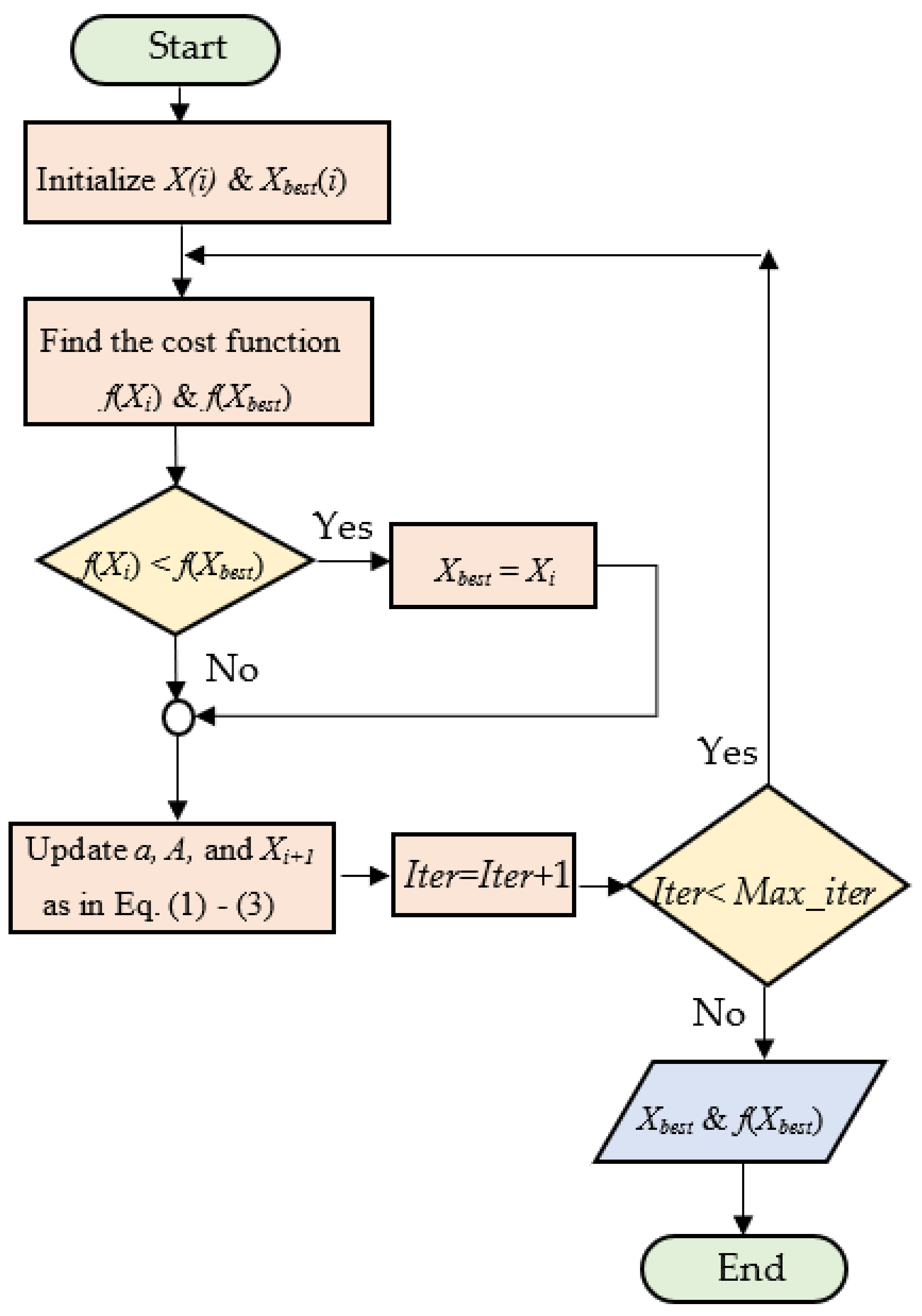
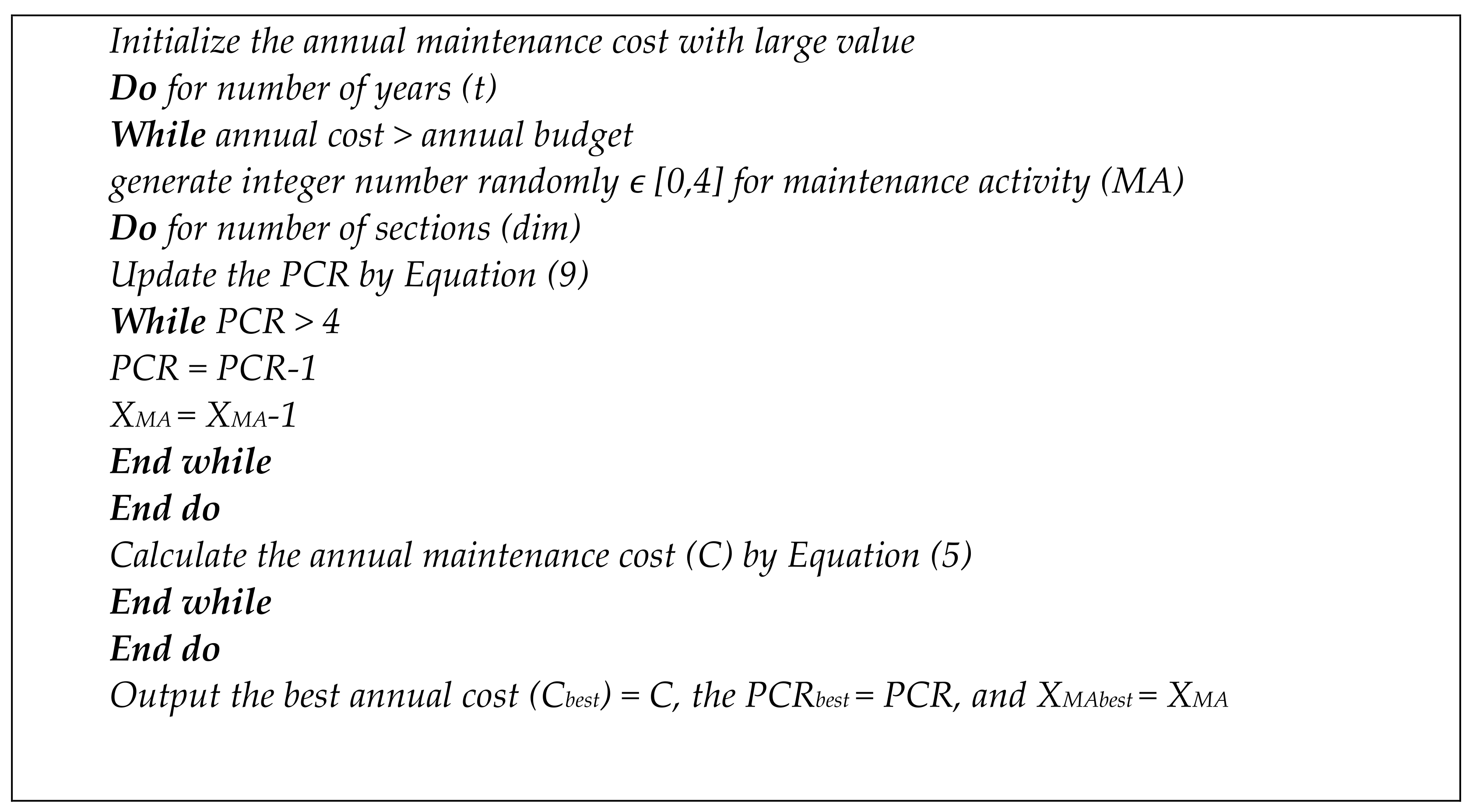

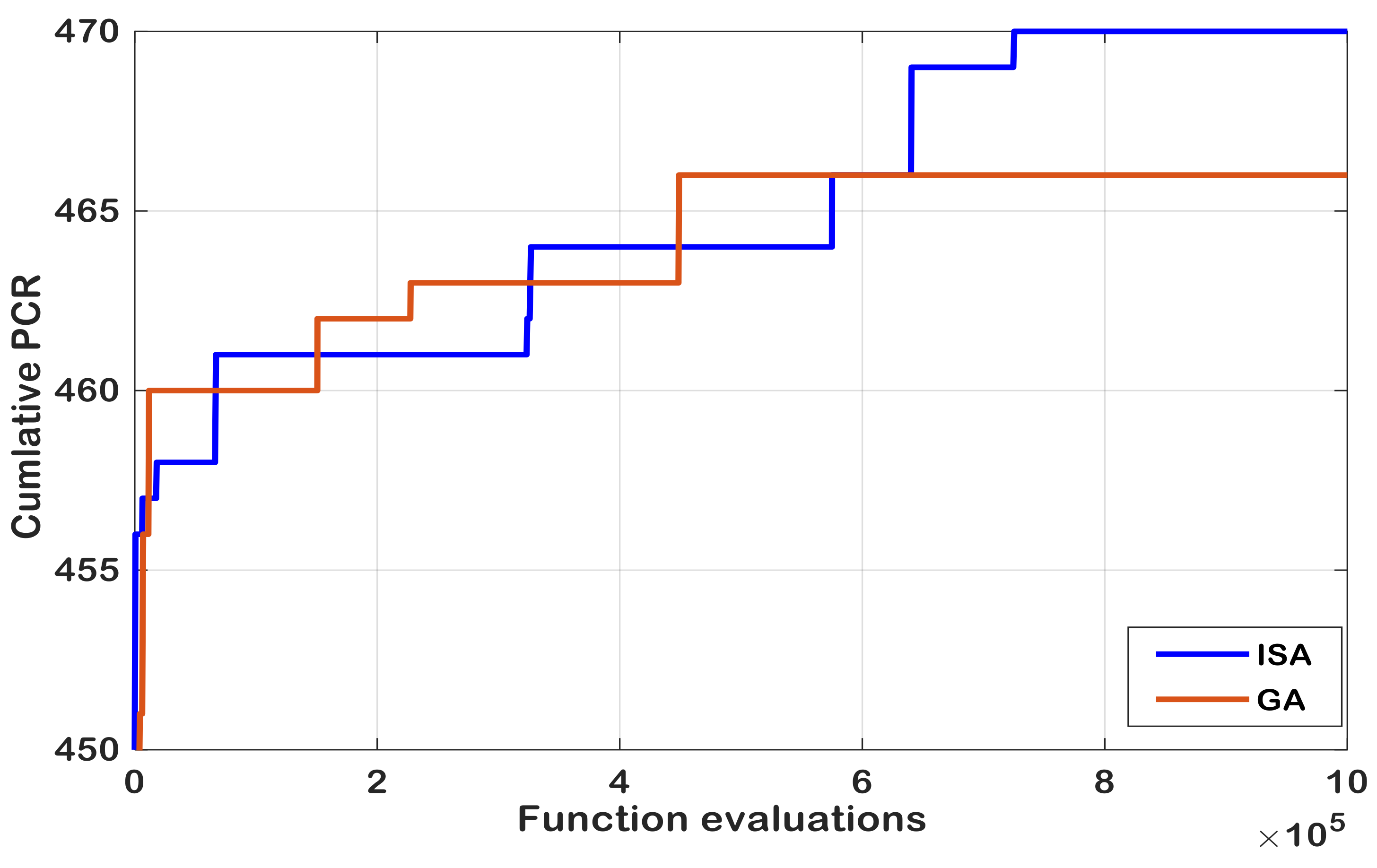
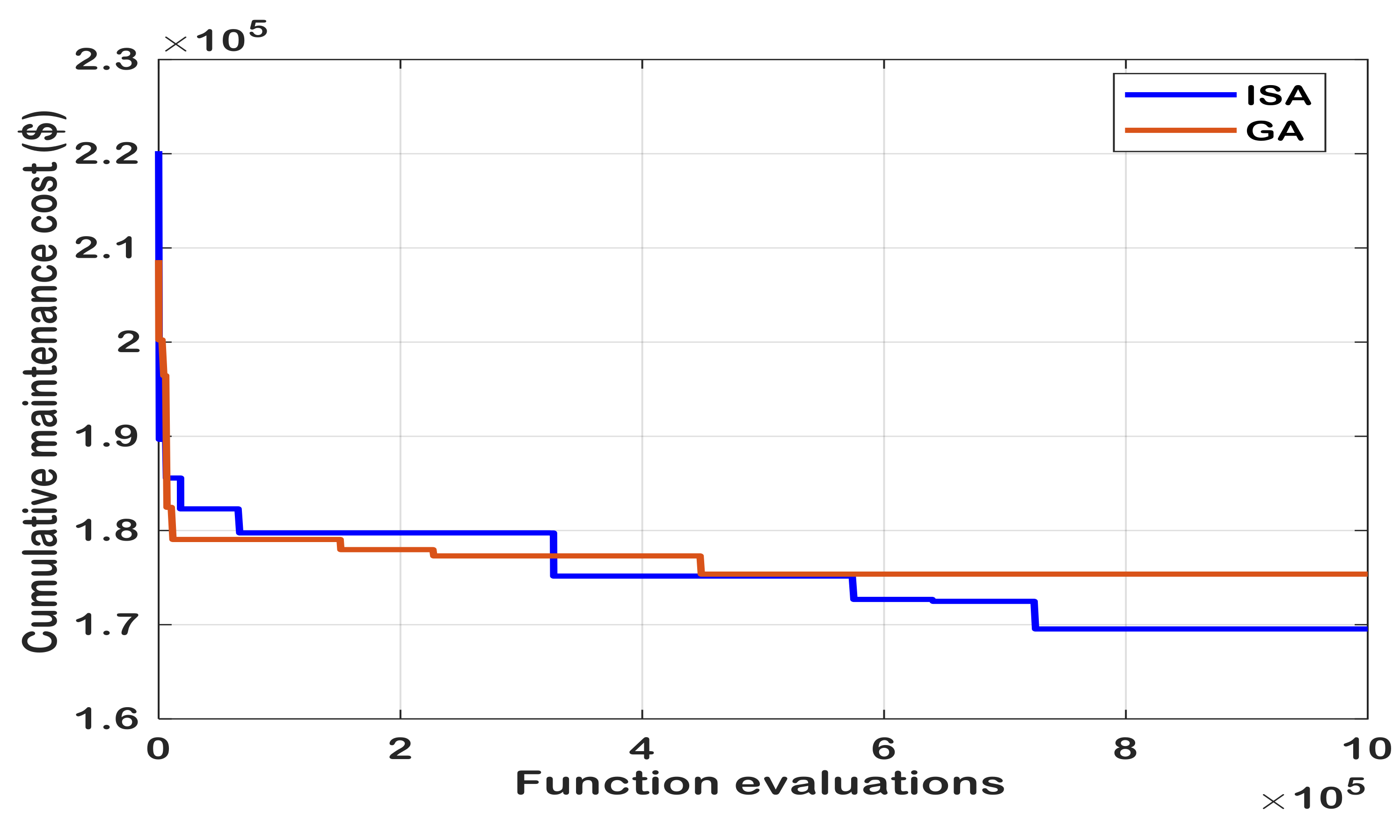
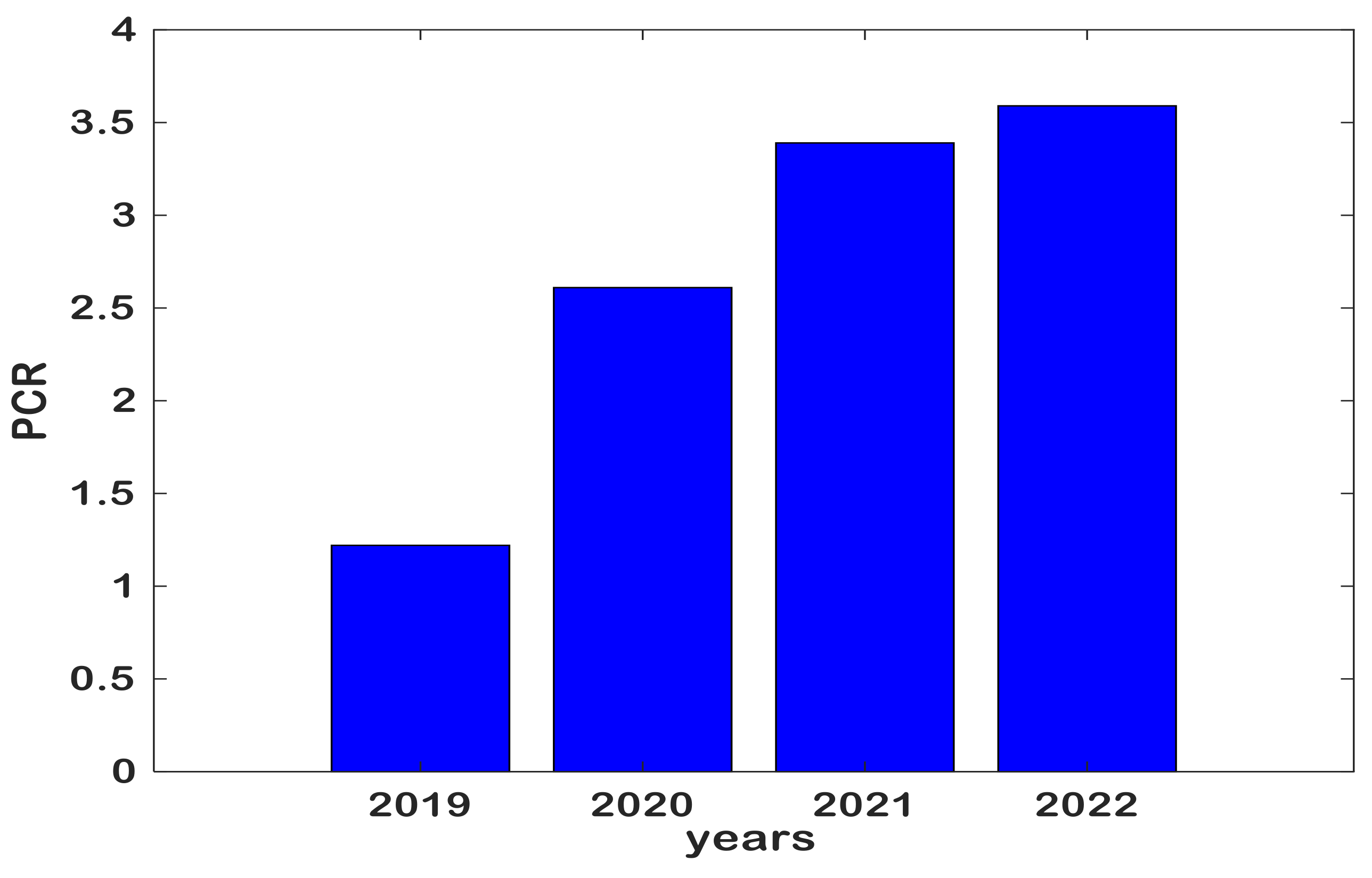


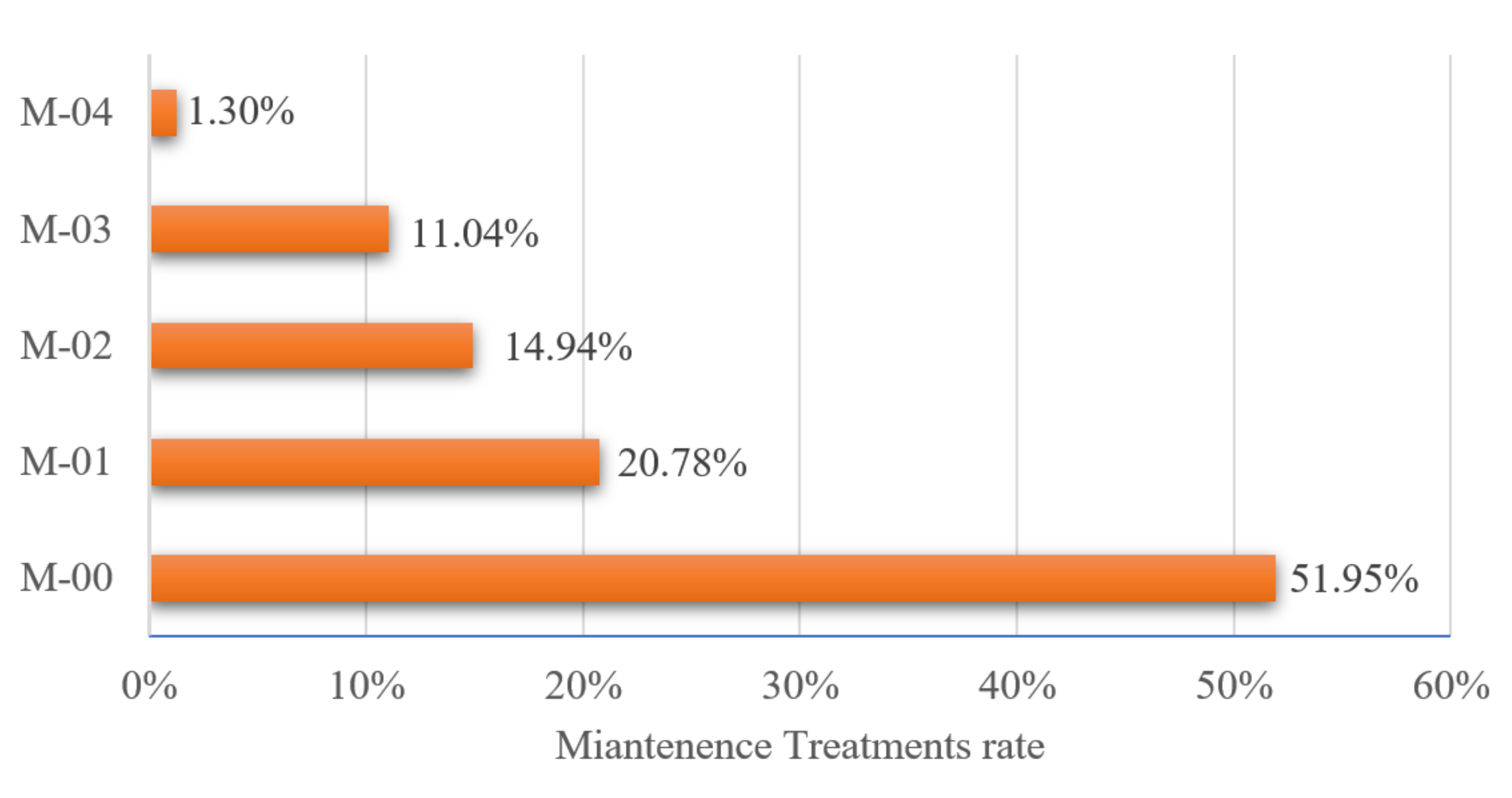
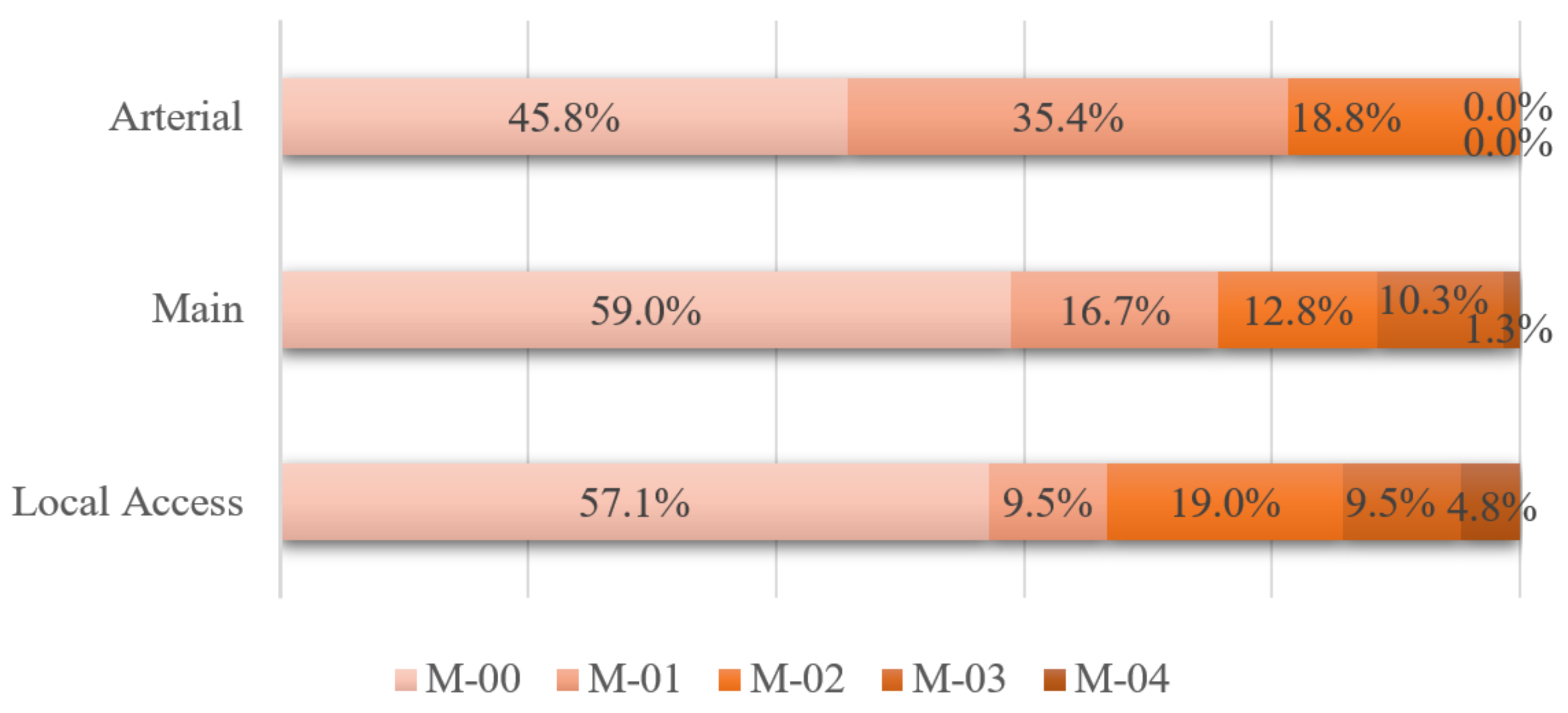
| PCR | IRI (m/km) | Condition Description |
|---|---|---|
| 0 | >10 | Failed: out of service |
| 1 | (6,10] | Poor condition: foremost maintenance is required |
| 2 | [4,6] | Fair condition: medium maintenance is required |
| 3 | [2,4) | Good condition: less maintenance is required |
| 4 | <2 | Excellent condition: maintenance is not required |
| PCR | PCR after Maintenance | ||||
|---|---|---|---|---|---|
| 1 | 2 | 3 | 4 | ||
| PCR before maintenance | 0 | M-01 | M-02 | M-03 | M-04 |
| 1 | ---- | M-01 | M-02 | M-03 | |
| 2 | ---- | ---- | M-01 | M-02 | |
| 3 | ---- | ---- | ---- | M-01 | |
| # | Street Name | Road Class | Section Code | Length (m) | Width (m) | Area (m2) | IRI | Road Condition | PCR |
|---|---|---|---|---|---|---|---|---|---|
| 1 | Sana’a Road | Arterial | 1R/100 | 92 | 7.1 | 656 | 5 | Fair | 2 |
| 2 | Sana’a Road | Arterial | 1L/100 | 243 | 7.1 | 1725 | 4 | Fair | 2 |
| 3 | Sana’a Road | Arterial | 2R/100 | 172 | 7.1 | 1221 | 6 | Fair | 2 |
| 4 | Sana’a Road | Arterial | 3/100 | 449 | 8 | 3592 | 7 | Poor | 1 |
| 5 | Sana’a Road | Arterial | 4/100 | 574 | 8 | 4592 | 12 | Bad | 0 |
| 6 | Sana’a Road | Arterial | 5/100 | 528 | 8 | 4224 | 11 | Bad | 0 |
| 7 | Sana’a Road | Arterial | 6/100 | 426 | 8 | 3408 | 13 | Bad | 0 |
| 8 | Sana’a Road | Arterial | 7/100 | 491 | 8 | 3928 | 8 | Poor | 1 |
| 9 | Sana’a Road | Arterial | 8/100 | 627 | 8 | 5016 | 9 | Poor | 1 |
| 10 | Sana’a Road | Arterial | 9/100 | 586 | 8 | 4688 | 13 | Bad | 0 |
| 11 | Al-Hodaidah | Arterial | 1R/200 | 211 | 5 | 1055 | 6 | Fair | 2 |
| 12 | Al-Hodaidah | Arterial | 1L/200 | 396 | 5 | 1980 | 3 | Good | 3 |
| 13 | Al-Hodaidah | Arterial | 2R/200 | 521 | 5 | 2605 | 5 | Fair | 2 |
| 14 | Al-Hodaidah | Arterial | 2L/200 | 875 | 5 | 4375 | 6 | Fair | 2 |
| 15 | Al-Hodaidah | Arterial | 3R/200 | 540 | 5 | 2700 | 5 | Fair | 2 |
| 16 | Al-Hodaidah | Arterial | 4/200 | 602 | 7 | 4214 | 3 | Good | 3 |
| 17 | Al-Souq | Main | 1/110 | 163 | 7 | 1141 | 7 | Poor | 1 |
| 18 | Al-Souq | Main | 2/110 | 238 | 7 | 1666 | 9 | Poor | 1 |
| 19 | Al-Souq | Main | 3/110 | 116 | 7 | 812 | 8 | Poor | 1 |
| 20 | Al-Souq | Main | 4/110 | 105 | 7 | 735 | 7 | Poor | 1 |
| 21 | Al-Souq | Main | 5/110 | 127 | 7 | 889 | 10 | Poor | 1 |
| 22 | Al-Souq | Main | 6/110 | 251 | 7 | 1757 | 6 | Fair | 2 |
| 23 | Al-Dahreen | Main | 1/120 | 285 | 7.2 | 2052 | 8 | Poor | 1 |
| 24 | Al-Dahreen | Main | 2/120 | 82 | 7.2 | 591 | 8 | Poor | 1 |
| 25 | Al-Dahreen | Main | 3/120 | 319 | 7.2 | 2297 | 6 | Fair | 2 |
| 26 | Al-Dahreen | Main | 4/120 | 276 | 7.2 | 1987 | 6 | Fair | 2 |
| 27 | Al-Dahreen | Main | 5/120 | 562 | 7.2 | 4046 | 9 | Poor | 1 |
| 28 | Al-Dahreen | Main | 6/120 | 107 | 7.2 | 770 | 9 | Poor | 1 |
| 29 | Al-Dahreen | Main | 7/120 | 586 | 7.2 | 4219 | 10 | Poor | 1 |
| 30 | Al-Nasieryah | Local Access | 1/116 | 694 | 8 | 5552 | 3 | Good | 3 |
| 31 | Al-Qahirah | Local Access | 1/112 | 329 | 6.5 | 2139 | 11 | Bad | 0 |
| 32 | Al-Mohandis | Main | 1/150 | 1348 | 6.3 | 8492 | 3 | Good | 3 |
| 33 | Al-Mahjan | Main | 1/130 | 567 | 7 | 3969 | 9 | Poor | 1 |
| 34 | Al-Mahjan | Main | 2/130 | 1028 | 7 | 7196 | 5 | Fair | 2 |
| 35 | Qarn Habab | Main | 1/160 | 156 | 6.1 | 952 | 13 | Bad | 0 |
| 36 | Qarn Habab | Main | 2/160 | 489 | 6.1 | 2983 | 11 | Bad | 0 |
| 37 | Qarn Habab | Main | 3/160 | 169 | 6.1 | 1031 | 12 | Bad | 0 |
| 38 | Qarn Habab | Main | 4/160 | 93 | 6.1 | 567 | 10 | Poor | 1 |
| 39 | Na’aman | Local Access | 1/113 | 725 | 6 | 4350 | 10 | Poor | 1 |
| 40 | Al-Helah | Main | 1/170 | 140 | 7.2 | 1008 | 7 | Poor | 1 |
| 41 | Al-Helah | Main | 2/170 | 307 | 7.2 | 2210 | 9 | Poor | 1 |
| 42 | Al-Helah | Main | 3/170 | 427 | 7.2 | 3074 | 8 | Poor | 1 |
| 43 | Haorah | Local Access | 1/111 | 761 | 8 | 6088 | 2 | Good | 3 |
| 44 | Haorah | Local Access | 2/111 | 352 | 8 | 2816 | 7 | Poor | 1 |
| 45 | Al-Gharabi | Main | 1/180 | 1401 | 7.1 | 9947 | 8 | Poor | 1 |
| 46 | Al-Gharabi | Main | 2/180 | 1926 | 7.1 | 13675 | 9 | Poor | 1 |
| 47 | Al-Ma’enah | Main | 1/140 | 889 | 7 | 6223 | 10 | Poor | 1 |
| 48 | Dhola’ah | Local Access | 1/114 | 315 | 6.1 | 1922 | 12 | Bad | 0 |
| 49 | Qirwee | Local Access | 1/115 | 431 | 4 | 1724 | 11 | Bad | 0 |
| Section | Input Variables of ISA Algorithm | Section | Input Variables of ISA Algorithm | ||||
|---|---|---|---|---|---|---|---|
| s | XMA(s, t = 1) | XMA (s, t = 2) | XMA (s, t = 3) | s | XMA(s, t = 1) | XMA (s, t = 2) | XMA (s, t = 3) |
| 1 | 1 | 0 | 1 | 26 | 2 | 0 | 0 |
| 2 | 0 | 1 | 0 | 27 | 1 | 2 | 0 |
| 3 | 2 | 0 | 0 | 28 | 3 | 0 | 0 |
| 4 | 1 | 2 | 0 | 29 | 1 | 0 | 1 |
| 5 | 0 | 1 | 1 | 30 | 0 | 1 | 0 |
| 6 | 0 | 2 | 1 | 31 | 2 | 2 | 0 |
| 7 | 1 | 2 | 0 | 32 | 0 | 0 | 0 |
| 8 | 1 | 1 | 1 | 33 | 0 | 1 | 1 |
| 9 | 1 | 1 | 1 | 34 | 0 | 0 | 0 |
| 10 | 0 | 2 | 1 | 35 | 4 | 0 | 0 |
| 11 | 2 | 0 | 0 | 36 | 2 | 1 | 0 |
| 12 | 1 | 0 | 0 | 37 | 2 | 1 | 1 |
| 13 | 2 | 0 | 0 | 38 | 3 | 0 | 0 |
| 14 | 0 | 2 | 0 | 39 | 3 | 0 | 0 |
| 15 | 2 | 0 | 0 | 40 | 3 | 0 | 0 |
| 16 | 0 | 1 | 0 | 41 | 2 | 1 | 0 |
| 17 | 3 | 0 | 0 | 42 | 0 | 3 | 0 |
| 18 | 2 | 1 | 0 | 43 | 0 | 1 | 0 |
| 19 | 3 | 0 | 0 | 44 | 0 | 3 | 0 |
| 20 | 0 | 3 | 0 | 45 | 0 | 0 | 0 |
| 21 | 3 | 0 | 0 | 46 | 0 | 0 | 0 |
| 22 | 2 | 0 | 0 | 47 | 1 | 0 | 0 |
| 23 | 2 | 0 | 1 | 48 | 2 | 2 | 0 |
| 24 | 2 | 1 | 0 | 49 | 4 | 0 | 0 |
| 25 | 2 | 0 | 0 | ||||
| Year | t = 0 | t = 1 | t = 2 | t = 3 | Sum of t = 1, 2, 3 |
|---|---|---|---|---|---|
| Total annual PCR | 60 | 128 | 166 | 176 | 470 |
| Average annual PCR | 1.22 | 2.61 | 3.39 | 3.59 | 9.59 |
| Annual cost ($) | -- | 78,272.06 | 70,650.90 | 20,623.38 | 169,546.34 |
Publisher’s Note: MDPI stays neutral with regard to jurisdictional claims in published maps and institutional affiliations. |
© 2021 by the authors. Licensee MDPI, Basel, Switzerland. This article is an open access article distributed under the terms and conditions of the Creative Commons Attribution (CC BY) license (https://creativecommons.org/licenses/by/4.0/).
Share and Cite
Alqaili, A.; Qais, M.; Al-Mansour, A. Integer Search Algorithm: A New Discrete Multi-Objective Algorithm for Pavement Maintenance Management Optimization. Appl. Sci. 2021, 11, 7170. https://doi.org/10.3390/app11157170
Alqaili A, Qais M, Al-Mansour A. Integer Search Algorithm: A New Discrete Multi-Objective Algorithm for Pavement Maintenance Management Optimization. Applied Sciences. 2021; 11(15):7170. https://doi.org/10.3390/app11157170
Chicago/Turabian StyleAlqaili, Abdulraaof, Mohammed Qais, and Abdullah Al-Mansour. 2021. "Integer Search Algorithm: A New Discrete Multi-Objective Algorithm for Pavement Maintenance Management Optimization" Applied Sciences 11, no. 15: 7170. https://doi.org/10.3390/app11157170
APA StyleAlqaili, A., Qais, M., & Al-Mansour, A. (2021). Integer Search Algorithm: A New Discrete Multi-Objective Algorithm for Pavement Maintenance Management Optimization. Applied Sciences, 11(15), 7170. https://doi.org/10.3390/app11157170






